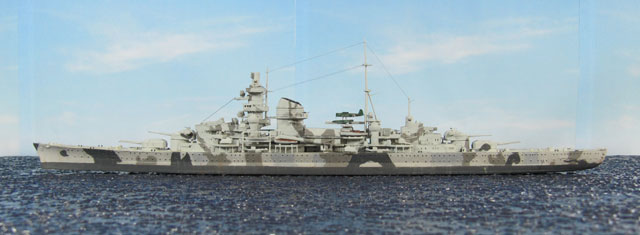by First Last

1/700 Admiral Hipper (Trumpeter)

Admiral Hipper was the first ship of a class German heavy cruisers, which were very large, but otherwise mediocre ships. Admiral Hipper was built 1935-39 by Blohm & Voss in Hamburg. She was part of the German occupation force of Norway in April 1940 and sunk the British destroyer Glowworm on the way (and was herself damaged in a collision with the sinking destroyer). She made several attempts in 1940 and 1941 to attack allied shipping and sunk nine cargo ships. During an attack on a allied convoy in the Barent See in December 1942, she sunk the destroyer Achates and the minesweepeer Bramble, but Admiral Hipper herself was heavely damaged by the light cruiser Sheffield. She was never fully repaired and was used afterwards only as training ship. In April 1945 was destroyed by RAF bombers in Kiel and the wreck was dismantled in 1948.
The model was built using the Trumpeter kit (1940 version). For the camouflage pattern shown on the cover, I would have to add the degaussing cable (contained in the 1941 version), therefore I decided to built Admiral Hipper in a camouflage pattern she had sometimes between end of June and beginning of August 1940. The pattern is shown on www.admiral-hipper-class.dk and photos of it could be found in Heavy Cruisers of the Admiral Hipper and the Prinz Eugen class by Miroslaw Skwiot ( Lublin, 2010).
The kit is unproblematic to build. The only major problem I had discovered too late to correct it: the waterline model has 4 mm too much freeboard, because the hull is divided at waterline as designed and shows the ship an empty state. I replaced the 20.3 cm and 10.5 cm gun barrels by brass parts made by BMK and Master, respectively. The 3,7 cm twins are Flyhawk parts, the 2 cm C/30 are a mixture of the kit’s and LionRoar’s parts. The mounting for the 2 cm Flak 30 on turret B and C are scratch built, the barrels are again PE parts by LionRoar. The FuMo22 radar is also a LionRoar part and was fit to the range finder part C19 (not C18). I made also some small modifications to the cranes and masts. The rigging is made from stretched sprue.
The camouflage pattern was made using Vallejo 153 for the superstructure, 154 for the hull and 155, 159, and 166 for the pattern. The waterline – which is painted high to depict the empty state of the hull – is painted with Vallejo 166. The wooded decks were painted with Vallejo 110.
References:
